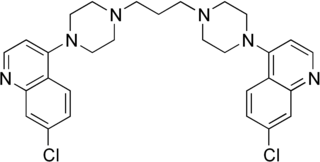| Combination of | |
|---|---|
| Dihydroartemisinin | Antimalarial |
| piperaquine | Antimalarial |
| Clinical data | |
| Trade names | DuoCotecxin, Artekin, Eurartesim, others |
| Synonyms | Dihydroartemisinin/piperaquine phosphate |
| Routes of administration | By mouth |
Dihydroartemisinin/piperaquine (DHA/PPQ) is a fixed dose combination medication used in the treatment of malaria. [1] It is a combination of dihydroartemisinin and piperaquine. [1] Specifically it is used for malaria of the P. falciparum and P. vivax types. [2] [3] It is taken by mouth. [2]

Malaria is a mosquito-borne infectious disease that affects humans and other animals. Malaria causes symptoms that typically include fever, tiredness, vomiting, and headaches. In severe cases it can cause yellow skin, seizures, coma, or death. Symptoms usually begin ten to fifteen days after being bitten by an infected mosquito. If not properly treated, people may have recurrences of the disease months later. In those who have recently survived an infection, reinfection usually causes milder symptoms. This partial resistance disappears over months to years if the person has no continuing exposure to malaria.

Dihydroartemisinin is a drug used to treat malaria. Dihydroartemisinin is the active metabolite of all artemisinin compounds and is also available as a drug in itself. It is a semi-synthetic derivative of artemisinin and is widely used as an intermediate in the preparation of other artemisinin-derived antimalarial drugs. It is sold commercially in combination with piperaquine and has been shown to be equivalent to artemether/lumefantrine.

Piperaquine is an antiparasitic drug used in combination with dihydroartemisinin to treat malaria. Piperaquine was developed under the Chinese National Malaria Elimination Programme in the 1960s and was adopted throughout China as a replacement for the structurually similar antimalarial drug chloroquine. Due to widespread parasite resistance to piperaquine, the drug fell out of use as a monotherapy, and is instead used as a partner drug for artemisinin combination therapy. Piperaquine kills parasites by disrupting the detoxification of host heme.
Contents
Side effects are uncommon. [3] Concerns include the possibility of QT prolongation. [3] Versions are available for use in children. [2] Use in early pregnancy is not recommended. [3] The two medications work by different mechanisms. [3]

Pregnancy, also known as gestation, is the time during which one or more offspring develops inside a woman. A multiple pregnancy involves more than one offspring, such as with twins. Pregnancy can occur by sexual intercourse or assisted reproductive technology. A pregnancy may end in a live birth, abortion, or miscarriage, though access to safe abortion care varies globally. Childbirth typically occurs around 40 weeks from the start of the last menstrual period (LMP). This is just over nine months, where each month averages 31 days. When measured from fertilization it is about 38 weeks. An embryo is the developing offspring during the first eight weeks following fertilization, after which, the term fetus is used until birth. Symptoms of early pregnancy may include missed periods, tender breasts, nausea and vomiting, hunger, and frequent urination. Pregnancy may be confirmed with a pregnancy test.
Dihydroartemisinin/piperaquine was approved for medical use in Europe in 2011. [2] It is on the World Health Organization's List of Essential Medicines, the most effective and safe medicines needed in a health system. [1] While it was available for about 6 USD per treatment course, efforts are underway as of 2010 to bring the price down one dollar per course. [3] It is commercially available in Africa and Asia. [2] It has been used to treat more than 4.5 million people as of 2017. [2]
A health system, also sometimes referred to as health care system or as healthcare system, is the organization of people, institutions, and resources that deliver health care services to meet the health needs of target populations.







